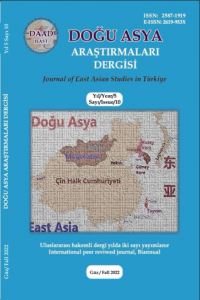Çin’in Uluslararası Kalkınma Yardımları Alanındaki Konumu ve Eşsizliği
Bu çalışma uluslararası sistemdeki hemen hemen tüm aktörlerin dikkate aldığı kalkınma yardımı sistemine odaklanmaktadır. Kalkınma yardımı aracı olmaktan kalkınma işbirliğinin bir parçası olmaya giden dönüşüm süreci, birtakım dönüm noktaları ile birlikte daha önemli hale gelmiştir. Bu sebeple öncelikle Çin tarihindeki önemli değişiklikler ile Çin kalkınma yardımlarının tarihi ve dönüşümü açıklanmıştır. Süreci açıklarken Pekin Konsensusu, Çin’in dahil olduğu bazı bildiriler ve anlaşmalar göz önüne alınmıştır. Bu bağlamda Çin yardımlarının özellikleri ve eşsizliği ayrıntılı şekilde incelenmiştir. Çalışmanın başlığında da belirtildiği üzere Çin bu alanda birtakım farklı özellikler sergilemektedir. Bu özellikler bir yandan avantajlar sağlarken bir yandan da uluslararası arenada Çin için zorluklar oluşturabilmektedir. Çalışmanın son bölümünde Çin’in alıcı ülke olmaktan aktif bir donor ülke olmaya giden süreçte karşılaştığı zorluklar ve bunlara eleştiriler analiz edilmiştir. Bu analizi yaparken raporlar ve resmi otoriteler tarafından açıklanan politikalar kullanılmıştır. Çin’in sıradan olmayan yardım yapısıda çalışmanın sonunda belirtilmiştir. Yardım politikalarının uygulamaları, Çin’in çizdiği yolu göstermektedir. Çalışmayı daha iyi anlamak adına çalışmanın değerlendirmesi de son bölümde yapılmıştır.
Anahtar Kelimeler:
Çin yardımları, kalkınma işbirliği, yardım sistemi, kalkınma yardımı kurumları, Çin yardım politikasının zorlukları
THE STANDING OF CHINA IN INTERNATIONAL DEVELOPMENT AID FIELD AND CHINA’S UNIQUENESS
This study focuses on a prevalent topic named development aid system that almost all the actors in international system consider. The transformation from being development aid tool to being a part of development cooperation became more important after some turning points in the countries’ history. For this reason, firstly the history and transformation of Chinese development aid are explained with the key changes in China’s history. The Beijing Consensus, some declarations and agreements are considered while explaining historical transformation. In this context, the features and the uniqueness of Chinese aid are explained in details. As indicated in the title of this study, China shows uniqueness in development aid field. While China get advantages of these features, these features may also create challenges in international arena for China. In the last part of the study, the challenges and critics that China faces are analyzed in the process that lasts from the beginning of being a recipient country to be an active donor country. The reports and international policies announced by official authorities and articles are used to analyze this process. The untypical form of Chinese aid is seen at the end of the study. The China’s implementations of the aid policies show the way China goes. To better understand and realize the study, the overall evaluation of the paper is situated in the last part of the study.
Keywords:
Chinese aid, development cooperation, aid system, institutions of development aid, challenges of Chinese aid policy,
___
- BINDER, Andrea, Meier, Claudia and Steets, Julia (2010), Humanitarian Aid: Truly Universal? A Mapping Study of NonWestern Donors, Research Paper No:12, Global Public Policy Institute, pp.1-41.
- BRAUTIGAM, Deborah (2008), “China’s African Aid: Transatlantic Challenges”, GMF Report, pp.1-32.
- BRAUTIGAM, Deborah (2011), “Aid with Chinese Characteristics: Chinese Foreign Aid and development finance meet the OECD-DAC Regime”, Journal of International Development, Vol: 23, Iss: 5, pp. 752-764.
- CHIN, T. Gregory and FROLIC, B. Michael (2007), “Emerging Donors in International Development Aid- The China Case”, PBDD, pp.1-22.
- DAVIES, Martyn (2008), How China delivers development aid to Africa, Centre for Chinese Studies, Beijing.
- FENNY, Simon and CLARKE, Matthew (2008), “Achieving the Millennium Development Goals in the Asia- Pacific Region: The role of International Aid”, Asia Pacific Viewpoint, Vol: 49, No:2, pp.198-212.
- GABAS, Jean Jacques (2009), “Emerging Countries and International Cooperation”, in The Emerging States. The Wellspring of a New World Order, pp. 197-208.
- LENGAUER, Sara (2011), “China’s Foreign Aid Policy: Motive and Method”, Centre for East-West Cultural and Economic Studies, Vol:9, Iss:2, pp.35-81.
- Lİ, Anshan (2007), “China and Africa: Policy and Challenges”, China Security, Vol:3, Iss:3, pp.69-93.
- MCCORMICK, Dorothy (2008), “China & India as Africa's New Donors: The Impact of Aid on Development”, Review of African Political Economy, Vol:35, Iss:115, pp. 73-92.
- CABRIA, Nicola (2013), Does China Plan and Evaluate Foreign Aid Projects Like Traditional Donors?, Stellenbosch University, available at: http://www0.sun.ac.za/ccs/wpcontent/uploads/2013/12/CCS_DP_Chinese_Foreign_Aid_Ca bria_2013_ONLINE_and_PRINT.pdf, (Accessed: 25.12.2017).
- CHINA WHITE PAPER (2014), China’s Foreign Aid- 2014, available http://www.china.org.cn/government/whitepaper/node_720 9074.htm, (Accessed: 25.12.2017).
- DEFRAIGNE, Jean- Christophe and BELLOGOLI, Serena (2012, June 28), “Ties between business and aid programs in Africa- A comparative analysis between the European and the Chinese”, EBHA Conference, , 2010, August 26-28, Glasgow, pp. 1-33. Available at http://pairault.fr/sinaf/doc_importes/detb.pdf, (Accessed: 28.12.2017).
- ECOSOC (2008), Background Study for the Development Cooperation Forum: Trends in South- South and Triangular Development Cooperation,pp. 1-54, available at: http://www.un.org/en/ecosoc/docs/pdfs/southsouth_cooperation.pdf, (Accessed: 27.12.2017).
- KOBAYASHI, Takaaki (2008), “Evolution of China’s Aid Policy”, JBIC Institute, pp.1-56, available at: https://www.jica.go.jp/jicari/IFIC_and_JBICI-Studies/jicari/english/publication/archives/jbic/report/working/pdf/w p27_e.pdf, (Accessed: 27.12.2017).
- MFA of the PRC, China's Initiation of the Five Principles of Peaceful Co-Existence, available at: http://www.fmprc.gov.cn/mfa_eng/ziliao_665539/3602_6655 43/3604_665547/t18053.shtml, (Accessed: 26.12.2017).
- OECD, China’s Development Cooperation, available at http://www.oecd.org/dac/dac-global-relations/chinasdevelopment-co-operation.htm, (Accessed: 26.12.2017).
- RAMO, Joshua Cooper, “The Beijing Consensus”, The Foreign Policy Centre, available at: http://www.xuanju.org/uploadfile/200909/2009091802163823 9.pdf, (Accessed: 26.12.2017).
- UN, Millennium Development Goals, available at: http://www.un.org/millenniumgoals/, (Accessed: 26.12.2017)
- ISSN: 2587-1919
- Yayın Aralığı: Yılda 2 Sayı
- Başlangıç: 2015
- Yayıncı: Abdürreşit Celil KARLUK
Sayıdaki Diğer Makaleler
ARİF DİRLİK’İN TÜRKÇE’YE ÇEVRİLMEMİŞ KİTAPLARI
Çin’in Uluslararası Kalkınma Yardımları Alanındaki Konumu ve Eşsizliği
ÇİN ULUSLARARASI İLİŞKİLER AKADEMİSİNDEKİ ULUSLARARASI SORUMLULUK TARTIŞMALARI
İLK TÜRKÇE (OSMANLICA) - JAPONCA DİLBİLGİSİ KİTABI VE SÖZLÜĞÜ ÜZERİNE NOTLAR
ÇİNLİLERİN MİLLET DÜŞÜNCESİNİN KÖKENLERİ VE ÖTEKİLERE BAKIŞI
